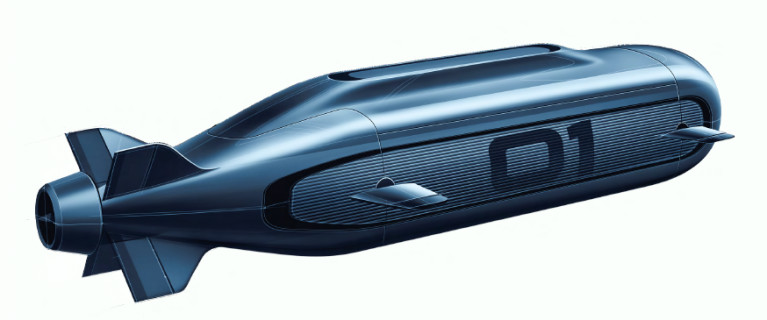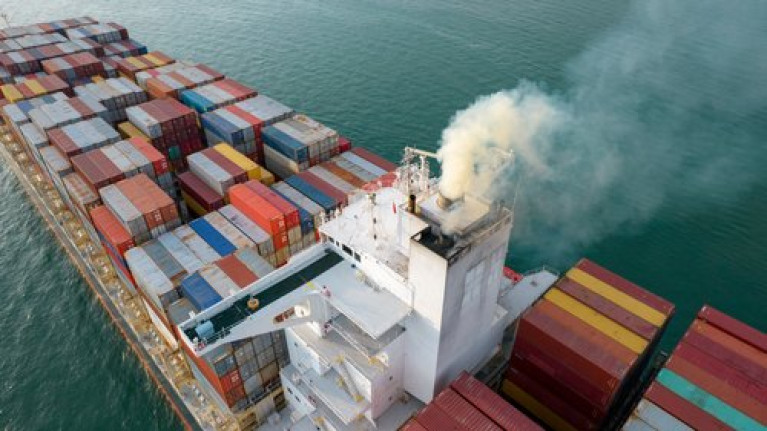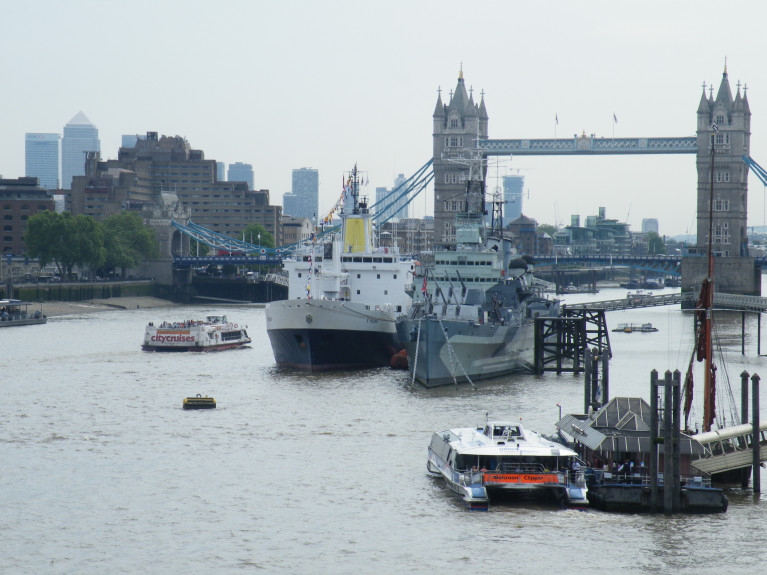Displaying items by tag: LISW21
'Green' Submarine A World First Amongst Winners of UK’s Biggest Clean Maritime Competition
A first ever green submarine study has been named as one of fifty-five winning projects of a £23m UK Government funded R&D competition, announced today by the Transport Secretary Grant Shapps in Greenwich during the 'greenest' London International Shipping Week (LISW21).
The Clean Maritime Demonstration Competition, announced as part of the Prime Minister’s Ten Point Plan for Green Industrial Revolution, is supporting the development of innovative technology to propel forward the Government’s commitment to have zero emission ships operating commercially by 2025 – creating hundreds of highly skilled jobs across the nation and establishing the UK as world leaders in clean maritime.
A fully automated net positive submarine fleet, powered entirely on green hydrogen, could help cleanse the oceans of toxic pollution by collecting microplastics on its pilot route between Glasgow and Belfast. While transporting cargo shipments, the fleet could secure significant emission savings of 27 tonnes of CO2 emissions in the first year of operation, with an overall mission to reduce 300m tonnes of CO2 emission as the fleet grows.
- Green submarine and shipping charge-points powered by offshore wind turbines will receive share of £23m R&D competition
- Maritime Minister supports the opening of the UK’s greenest cruise terminal at the Port of Southampton
- Comes as UK sets out intention to eliminate all emissions from shipping by 2050
Also amongst the winners is an all-electric charge-point connected to an offshore wind turbine. The charge-points will be able to power boats using 100% renewable energy generated from the turbine offering potential savings of up to 131,100 tonnes of CO2e emissions per year - the equivalent of removing over 62,000 cars from our roads. Similar to roadside Electric Vehicle chargepoints, these will be operated by semi-automated control, meaning that sailors can moor up by the wind turbine chargepoint, plug in, charge up, then sail on.
Announcing the winners in Greenwich, the heart of British maritime on the state-of-the art Royal Navy ship, HMS Albion, the Transport Secretary outlined how this is the latest in a string of Government initiatives aimed at cutting emissions in the sector as part of London International Shipping Week – including joining other nations in supporting a world leading absolute zero target for international shipping emissions by 2050.
Transport Secretary, Grant Shapps said: “As a proud island nation built on our maritime prowess, it is only right that we lead by example when it comes to decarbonising the sector and building back greener.
“The projects announced today showcase the best of British innovation; revolutionising existing technology and infrastructure to slash emissions, create jobs and get us another step closer to our decarbonisation targets.”
This comes as Maritime Minister Robert Courts supports the opening of the UK’s greenest cruise terminal. The Horizon Cruise Terminal at the Port of Southampton, Europe’s leading cruise turnaround port, is the first of its kind, using an innovative mix of solar panelled roofing and clean energy shore power plug-in charging for ships - pioneering the way towards greener cruising.
Maritime Minister, Robert Courts said: “As the cruising sector bounces back from the pandemic, it’s important that our environmental commitments are at the heart of everything we do.
“Building state-of-the-art green infrastructure at cruise terminals, helps us move towards cleaner cruising; creating more spaces for these ships to dock and putting us on track to hit Net Zero by 2050.”
Founder & CEO of Oceanways, Dhruv Boruah said “We would like to thank our Transport Secretary Grant Shapps MP for selecting Oceanways to support DfT’s mission to decarbonise shipping and aid our Prime Minister's commitment to build back better. Time is running out and it is imperative we don’t settle for 1% more efficiency in an existing system, but instead radically re-think to create innovative solutions.
“It is not just #JetZero and Oceanways has assembled a world-class team to pioneer #SubZero by creating the new market of net positive underwater transport systems with zero-emission cargo submarines as an innovative tool to decarbonise shipping and clean up our ocean”
Paul Cairns, Managing Director of MJR Power & Automation said: “We are delighted to have been selected as one of the winners of the Clean Maritime Demonstration Competition, which will enable us to demonstrate our world leading technology for offshore charging of vessels, and our commitment to supporting decarbonisation of marine operations.
“The support of DfT and InnovateUK is crucial to delivering Net Zero Greenhouse Gas emissions by 2050 and we are proud to be recipients of their support.”
The initiatives follow on from the Government’s previous commitments outlined in the world-leading Transport Decarbonisation Plan to explore the establishment of a dedicated function for creating zero-emission ship building and R&D for autonomous vessel sailings, under the function of UK Shore.
Based in the Department for Transport, UK Shore will unlock the necessary industry investment in clean maritime technologies, tackling supply and demand side barriers as well as developing infrastructure and consumer confidence in clean maritime technologies.
UK Calls for Zero Global Shipping Emissions by 2050 As Greenest Ever LISW Begins
At the greenest London International Shipping Week (see story), the UK backs a world leading absolute zero target for international shipping emissions by 2050, the Transport Secretary Grant Shapps has announced.
This target, which would need to be agreed through the International Maritime Organization, would be a significant increase of ambition for the sector, which is currently accountable for 3% of global emissions.
The announcement yesterday comes as the British Government launches the greenest ever London International Shipping Week (LISW), building on a string of initiatives aimed at slashing emissions and establishing the UK as international leaders in green maritime.
- UK to push for international shipping emissions to reach absolute zero by 2050
- Transport Secretary sets out ambitious global 2050 target as UK Government launches greenest ever International Shipping Week
- Vision of zero emission vessels entering into commercial service by 2025 opening the possibility for cleaner and greener channel crossings in the next decade
At a speech tomorrow, the Transport Secretary will announce the winners of the multimillion pound Clean Maritime Demonstration Competition, focused on innovative green maritime solutions, launched as part of the Prime Minister’s Ten-Point plan for a green industrial revolution last November.
He is also expected to reassert the importance of building a thriving maritime sector focused on innovation, highlighting his ambition to have zero emission vessels entering into commercial service by 2025 which opens the possibility for cleaner and greener channel crossings in the next decade.
These initiatives follow on from commitments outlined in the world-leading Transport Decarbonisation Plan to explore the establishment of a UK Shipping Office for Reducing Emissions (UK SHORE), a dedicated unit within the Department for Transport focused on decarbonising the maritime sector.
Transport Secretary, Grant Shapps said: “As a maritime nation with a rich history, and host of COP26 this year, we are proud to be at the forefront of the greener era for maritime, charting an international course for the future of clean shipping.
“I’m incredibly excited by the changes happening in this sector, with the speed of progress highlighted by the prospect of zero emission commercial vessels in UK waters in the next few years and green Channel crossings within a decade.
“Taking action now allows us to lead the charge on this global shift, creating highly-skilled jobs for British workers and shaping the landscape for what clean shipping and trade will look like for future generations.”
As the greenest shipping week to date, the UK is focused on working in collaboration with the sector to build a strong sustainable future for UK maritime. As recently published in the intergovernmental panel on climate change report, warming is happening quicker than previously estimated, therefore action is needed across all sectors and the UK will do all it can to slash emissions from shipping.
Throughout the week Ministers and industry will be leading a host of events taking stock of the sector’s progress:
Kicking off with a Ministerial roundtable at the Foreign Office on Monday 13 September, leaders from across the sector will discuss how to level up all parts of the UK with a focus on its decarbonisation, coastal communities and port towns and industries.
The Department will publish its Biennial Report on Tuesday, outlining the strength of the sector, the next phase for its recovery from the pandemic, and progress on our ambitious Maritime 2050 strategy.
On Wednesday the Transport Secretary will announce the winners of the Clean Maritime Demonstration Competition, while the Maritime Minister, Robert Courts will be at Port of Southampton opening the newest cruise terminal which is the greenest one yet.
Minister Courts is also set to take centre stage on Thursday Evening at the coveted Gala Dinner in the iconic National Maritime Museum in Greenwich, the heart of British maritime, where he will outline the future for UK maritime and the opportunities that exist as we build global trading networks.
The week will be rounded off with the Maritime Minister joining Mersey Maritime at the end of the week for its annual Awards event, where he will present the DfT Maritime 2050 Award – celebrating industry action towards our shared Maritime 2050 ambitions.
IMDO at London International Shipping Week (LISW21)
The Irish government's development, promotional and marketing office for the shipping services sectors, the IMDO is among the sponsors of the high-profile biennial London International Shipping Week, writes Jehan Ashmore.
The Irish Maritime Development Office (IMDO) sponsor role in the premier global and maritime event week (13-17 Sept) is where the LISW21 provide an opportunity for the international and UK maritime community to get back together again. This time face-to-face and for the first time since the COVID-19 pandemic started.
During LISW's 'must attend ' events, this will offer up to 250 in-person, hybrid and virtual industry functions and unique networking opportunities for leaders across all sectors of the international shipping industry and the UK shipping industry. Take a click here for conference speakers and panelists.
Among the events Afloat has consulted is the Coastal Shipping Seminer, to be held tomorrow, Wednesday, 15 Sept. Attendees will gain new insights into coastal shipping and understand how to revolutionise the green supply chain. To register this British Ports Association seminar, click this link for the event attended by ports and shipping operators.
As for the high profile LISW21 Conference (also tomorrow) this is to take place at the International Maritime Organization’s (IMO) headquarters on the Thames along Albert Embankment in central London.
In addition a glittering black tie Gala Reception and Dinner held aptly in the National Maritime Museum downriver in Greenwich is on Thursday, 16 September. This key event will attract the very highest-level from the UK government and shipping industry leaders across the UK and from around the world.
For further details of LISW21 there is the Official Event Guide (click to download) which is packed with information on this year’s premier global shipping and maritime event.
The events (calender) will be held by international shipping and marine trade associations and the UK Government, as well as by official sponsors of the week.
Both face-to-face and virtual events will take place, and seamlessly be blended via the dedicated LISW21 Portal. To access the portal and register for free online events click here.
During the week of LISW, a daily breakfast morning news programme is podcast from 7am































































